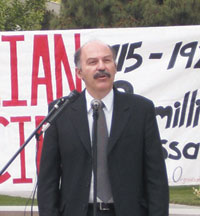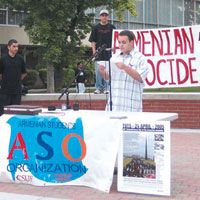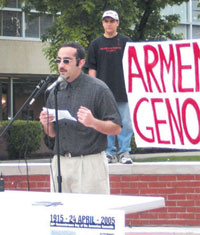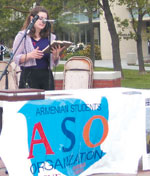Nyrie Karkazian
Staff Writer

A crowd of people stood solemnly in the Free Speech Area at Fresno State, April 22, in honor of the 2 million people who died in the Armenian Genocide of 1915.
Members of the Armenian Students Organization held a large sign in the background that read “Armenian Genocide, 1915-1923, 2 million massacred,” as the crowd waited in silence for the program to begin.
The sad and drawn-out hum of Armenian duduk music played as Hakop Tataryan, Armenian Students Organization president, approached the Free Speech platform to open the ceremony.

On Thursday April 21 Governor Schwarzenegger signed SB424, a piece of legislation sponsored by Senator Chuck Poochigian, which permanently designated April 24th as the “Day of Remembrance of the Armenian Genocide,” said Tataryan.
With growing attempts to revise the historical record of this period and denial of truth by the Turkish government, it’s vitally important that false depictions of the tragedies of the Genocide are rejected,” Poochigian said. “SB 424 will help ensure that generations to come in California will continue to understand and recognize April 24th as the Day of Remembrance of the Armenian Genocide.”

Tataryan, who opened the ceremony with his heartfelt comments, was followed by two students, who read poetry. The first poem called “The Dance,” was read in English by Gary Krboyan. The poem was written by Armenian writer Siamanto, who had been killed in the genocide, and spoke of women being tortured during the massacre. The second poem was recited in Armenian by Armine Sargsyan.
Professor Barlow Der Mugrdechian of the Armenian Studies Program, was the keynote speaker of the day, and spoke on the history of the genocide. He mentioned Taniel Varoujan, a great Armenian poet, who was brutally murdered by the Young Turk government at the age of 31 in 1915.

According to Shant Norashkharian’s biography of Varoujan, an eyewitness of his martyrdom said that after being arrested, Varoujan and the other prisoners were robbed, taken to the woods and completely stripped. Then they were tied to the trees one-by-one and slowly cut open by the policemen who took them there. Their screams could be heard from afar.
“The last generation of survivors is slowly passing away. They were the last people to have seen Armenia with their own eyes,” Der Mugrdechian said. “By joining together at this ceremony, we honor their memory, and continue the struggle for justice.”
There are virtually no Armenians left in the area that was Armenia’s original homeland, which is now occupied by Turkey. Although the Turkish government continues to deny the genocide and mass killings to this day, the Armenian people are determined to combat this denial with whatever means necessary.

Stephanie Stockdale, a student in the Armenian Studies Program, said that she thinks that there needs to be recognition by other nations, especially Turkey.
Red carnations were passed out by the ASO toward the end of the commemoration as the duduk music began playing once again. Each person stood in line to lay their flower beside a small model of the Armenian Genocide monument in Armenia called Dzidzernagapert in remembrance of the dead.
“The people who were in the death marches of the Genocide marched because they saw rape, their land was taken, their families were stolen from them, but they continued so that their stories would be told,” said Sevag Tateosian, who was at the event. “That’s what we are doing here, so that their stories are told, so that they marched for something.”
 Hye Sharzhoom Armenian Action
Hye Sharzhoom Armenian Action